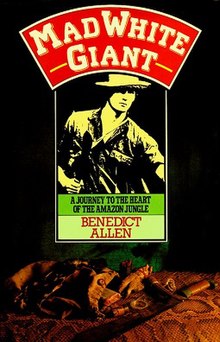Mad White Giant
 First edition | |
| Author | Benedict Allen |
|---|---|
| Country | United Kingdom |
| Language | English |
| Genre | adventure |
| Publisher | MacMillan (UK,1985) Flamingo (1992) Faber and Faber (2002) |
Publication date | 1985 |
| Media type | Print (paperback and hardback) |
| Pages | 256 |
| ISBN | 978-0-571-20617-9 |
| OCLC | 48932697 |
Mad White Giant: A Journey to the Heart of the Amazon Jungle is a 1985 semi-autobiographical adventure novel by British explorer and author Benedict Allen. It details Allen's travels between the mouths of the Orinoco and the Amazon rivers.[1] In the United States, the novel was published under the title Who Goes Out In The Midday Sun?
Plot[edit]
Mad White Giant begins with Allen recounting the role of Amazonia in his childhood fantasies.[2] The novel then describes the author's travels between the Orinoco and the Amazon rivers, a trip of over 1500 miles.[1] During his travels, he befriends natives who refer to him as "Mad White Giant", or by his preferred nickname Louco Benedito.[2]
Allen is later abandoned by his two Carib companions, Yepe and Pim, who go to work for Brazilian miners.[2] Allen also adopts a dog, named Cashoe (meaning 'dog' in one of the Indian dialects), whose actions capsize Allen's canoe and leave him stranded in the Amazonian jungle. After a grueling period of starvation, recounted as a series of diary entries (actually written in one sitting[3]), Allen decides to shoot and eat Cashoe to survive.[4][5]
Reception[edit]
The publication of Mad White Giant was greeted with some controversy.[5] Allen was visited by two RSPCA inspectors who inquired about the welfare of his family pets.[1] Several commentators doubted that Allen could have travelled his reported route within three months, leading to the cancellation of a lecture he was to give to the Royal Geographical Society.[5] Allen admits that Mad White Giant is "unreliable" in terms of factual detail, a deliberate bid to distance his novel from the traditional travelogue genre.[1] He also attributes any potential inaccuracies to the loss of his notes in a canoe capsizing, and in changes made to protect a travelling companion.[5] Allen stated of his novel's integrity:
I think of myself as a very truthful person and it upsets me if people think I'm a fraud. The book wasn't meant to be a scientific document. It was an adventure story which veiled an angry cry against what the white man has done and how we are going about exploiting these places. [...] I felt I was being criticised for writing about a very real journey as if it was a standard travelogue, which it quite clearly wasn't.[5]
Douglas Ivison considers Mad White Giant to be written "within a tradition of British writing, in which boys had to venture out to the colonies in order to learn to become men."[2] He further argues, however, that Allen achieves a "transcendence" that distances his writing from the "imperialist and capitalist, even patriarchal, discourses in which it is embedded."[2]
References[edit]
- ^ a b c d Allen, Benedict. "Benedict Allen Books". Benedict Allen official website. Archived from the original on 2 April 2012. Retrieved 31 January 2012.
- ^ a b c d e Ivison, D. (2003) "Travel Writing at the End of Empire: A Pom Named Bruce and the Mad White Giant," English Studies in Canada, 29.3–4 (2003), 200–19
- ^ Allen, B. (1992) "Preface", Mad White Giant, Flamingo: Hammersmith, London, UK
- ^ Hollingshead, I. (10 November 2010). "Danger: the world is on its way". The Telegraph. Archived from the original on 24 October 2021. Retrieved 24 October 2021.
- ^ a b c d e "White Man in a Blue Heaven". Geographical. 70 (11). November 1998. Archived from the original on 18 May 2019.
